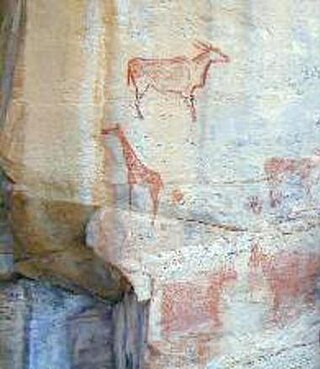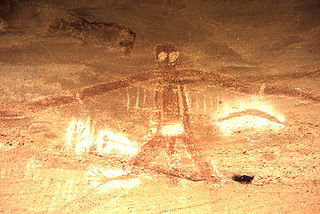Related Research Articles

Indigenous Australian art includes art made by Aboriginal Australians and Torres Strait Islanders, including collaborations with others. It includes works in a wide range of media including painting on leaves, bark painting, wood carving, rock carving, watercolour painting, sculpting, ceremonial clothing and sandpainting; art by Indigenous Australians that pre-dates European colonisation by thousands of years, up to the present day.

In archaeology, rock art is human-made markings placed on natural surfaces, typically vertical stone surfaces. A high proportion of surviving historic and prehistoric rock art is found in caves or partly enclosed rock shelters; this type also may be called cave art or parietal art. A global phenomenon, rock art is found in many culturally diverse regions of the world. It has been produced in many contexts throughout human history. In terms of technique, the four main groups are:

The Tsodilo Hills are a UNESCO World Heritage Site (WHS), consisting of rock art, rock shelters, depressions, and caves in Botswana, Southern Africa. It gained its WHS listing in 2001 because of its unique religious and spiritual significance to local peoples, as well as its unique record of human settlement over many millennia. UNESCO estimates there are over 4500 rock paintings at the site. The site consists of a few main hills known as the Child Hill, Female Hill, and Male Hill.

Ngarrabullgan, officially named Mount Mulligan by the State, is a large tabletop mountain located 100 kilometres west of Cairns in the north of Queensland (Australia).

An Australian Aboriginal sacred site is a place deemed significant and meaningful by Aboriginal Australians based on their beliefs. It may include any feature in the landscape, and in coastal areas, these may lie underwater. The site's status is derived from an association with some aspect of social and cultural tradition, which is related to ancestral beings, collectively known as Dreamtime, who created both physical and social aspects of the world. The site may have its access restricted based on gender, clan or other Aboriginal grouping, or other factors.

Diepkloof Rock Shelter is a rock shelter in Western Cape, South Africa in which has been found some of the earliest evidence of the human use of symbols, in the form of patterns engraved upon ostrich eggshell water containers. These date around 60,000 years ago.

Gabarnmung is an archaeological and rock art site in south-western Arnhem Land, in the Top End of Australia’s Northern Territory. Habitation of the site has been dated to at least 44,000 years ago, placing it among the oldest radiocarbon dated sites in Australia. The oldest rock art was produced more than 28,000 years ago, making it the oldest securely dated prehistoric art in Australia. The cave was still visited by members of the Jawoyn within living memory, possibly until as late as the 1950s, but its existence had been forgotten until its 2006 rediscovery.
The Keilor archaeological site was among the first places to demonstrate the antiquity of Aboriginal occupation of Australia when a cranium, unearthed in 1940, was found to be nearly 15,000 years old. Subsequent investigations of Pleistocene alluvial terraces revealed hearths about 31,000 years BP, making Keilor one of the earliest sites of human habitation in Australia. Remains of megafauna suggest a possible association with Aboriginal hunting.

Aboriginal sites of Victoria form an important record of human occupation for probably more than 40,000 years. They may be identified from archaeological remains, historical and ethnographic information or continuing oral traditions and encompass places where rituals and ceremonies were performed, occupation sites where people ate, slept and carried out their day to day chores, and ephemeral evidence of people passing through the landscape, such as a discarded axe head or isolated artefact.
New Guinea II is a limestone cave and rockshelter on the Snowy River at the end of New Guinea Track, near Buchan, Victoria. The cave was within the country of the Krowathunkooloong clan of the Gunaikurnai nation. The deep cave system has an overhanging cliff that creates a rock shelter at the entrance facing the river. Excavations in the 1980s carried out by archaeologist Paul Ossa and a team from La Trobe University found stone artefacts, and other signs of occupation that were dated to almost 20,000 BP.
Cloggs Cave is a limestone cave and rockshelter with significant Aboriginal archaeological deposits, located on a cliff along the Snowy River gorge near the town of Buchan, Victoria.
Sandor (Alexander) Gallus was a Melbourne archaeologist, most famous for his investigations of Pleistocene Aboriginal occupation at Koonalda Cave in South Australia and the Dry Creek archaeological site in Keilor, Australia, which helped demonstrate the great antiquity of Aboriginal occupation of Australia.
Kutikina Cave is a rock shelter located on the Franklin River in the South West Wilderness, a World Heritage Area in the Australian state of Tasmania.
Warratyi is the site of a rock shelter in the Flinders Ranges in South Australia. Located around 550 kilometres (340 mi) north of Adelaide and about 200 kilometres (120 mi) inland, it has been identified as the oldest known site of human habitation in inland Australia. Newspapers reported that this rock shelter was discovered by chance in 2011 by a local resident who stumbled upon it while looking for somewhere to go to the toilet. Researchers found thousands of artefacts and bone fragments, which enabled them to date the shelter's occupation to a number of periods between 49,000 and 10,000 years ago. The finds include the earliest evidence in Australia of the development of bone and stone-axe technology, the use of ochre, and interaction with megafauna such as Diprotodon.
Madjedbebe is a sandstone rock shelter in Arnhem Land, in the Northern Territory of Australia, possibly the oldest site of human habitation in Australia. It is located about 50 kilometres (31 mi) from the coast. It is part of the lands traditionally inhabited by the Mirarr, an Aboriginal Australian clan of the Gaagudju people, of the Gunwinyguan language group. Although it is surrounded by the World Heritage Listed Kakadu National Park, Madjedbebe itself is located within the Jabiluka Mineral Leasehold.
Blacks Camp is a heritage-listed area in New South Wales, Australia. It is significant for its historical connections to the Wiradjuri indigenous people during the colonial era and early twentieth century, when the camp site formed part of a Christian mission station. Located on University Road, Wellington in the Central West region of the state, it is also known as The Spring Flats. Today the site is mostly vacant and agricultural land, including a residence owned by New South Wales Land and Property Information (LPI), an agency of the Government of New South Wales. The property was added to the New South Wales State Heritage Register on 18 November 2011.
Parramatta Sand Body Conservation Area and Military Barracks Site is a heritage-listed archaeological site relating to both Aboriginal and European occupation at George and Harris Streets, Harris Park, City of Parramatta, Sydney, New South Wales, Australia. It was added to the New South Wales State Heritage Register on 8 July 2011.
Bambata Cave is one of the Southern Africa prehistoric sites situated in Motobo National Park along with Inanke, Nswatugi, Pomengwe and Silozwane caves in Zimbabwe.
Earlwood Aboriginal Art Site is a heritage-listed Aboriginal cultural site at Earlwood, City of Canterbury-Bankstown, New South Wales, Australia. It is also known as Aboriginal Art and Midden. It was added to the New South Wales State Heritage Register on 27 November 2009.
Calga Aboriginal Cultural Landscape is a heritage-listed site at Peats Ridge Road, Calga, Central Coast Council, New South Wales, Australia. It is also known as Calga Aboriginal Women's Site and Calga Aboriginal Sites. It was added to the New South Wales State Heritage Register on 1 October 2019.
References
- ↑ R.G. Gunn. Mudgegonga 2, Aboriginal rock art site (Site 8224/001) : a detailed recording of the art and its context with an assessment of its archaeological significance, Victoria Archaeological Survey, Melbourne, 1987
- ↑ Aldo Massola, The rock-shelter at Mudgegonga, Field Naturalists Club of Victoria, Vol. 83 No. 4 April 1966
- ↑ Graham Frederick Perham, Mud and stone: a technological analysis of a quartz industry in North East Victoria, La Trobe University, Dept. of Archaeology, 1985
- ↑ Rock art restoration plan seen as desecration, Jewel Topsfield, The Age December 8, 2008
- Josephine Flood, Archaeology of the Dreamtime, J. B. Publishing